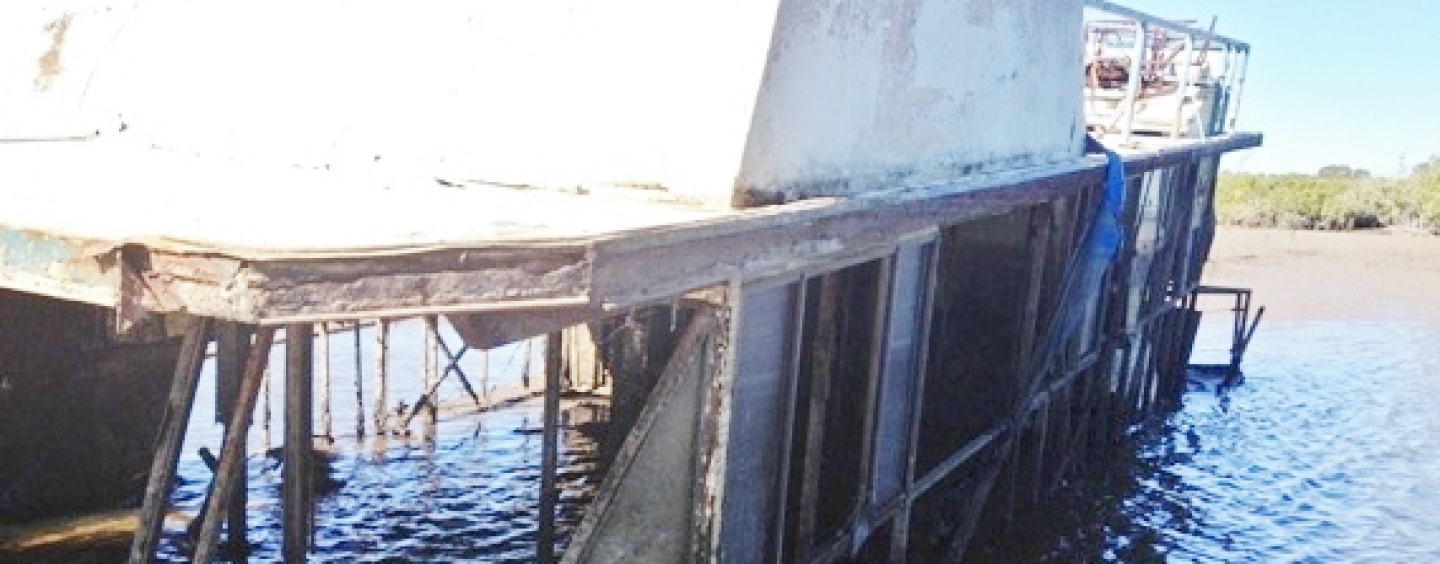Even the best constructed boats have to end their lives someday. But when this day comes, what happens to your beloved sailing or motoring beauty?
Traditionally, old timber or steel boats would float up a creek and degrade over time, or become an old shipwreck. These days there is an oversupply of typically small crafts and large boats manufactured out of fibreglass since its introduction in the 1950s. Fibreglass was picked as the material of choice over wood and steel for commercial and recreational boats due to its short term benefits, e.g. a reduction in maintenance with no painting required (easy to patch leakages) and good mechanical strength and stiffness for its weight. Fibreglass meant a change from labour intensive methods to a faster system that required a less-skilled workforce and a dependence on imported materials. This meant parts were not as easily reused or recycled like other boat-building materials (e.g. wood, aluminium, steel) leading to an oversupply of second-hand boats.
Fibreglass boats can have a typical lifespan of up to 40 years, but are often difficult and expensive to repair, unlike materials such as wood which can last a lifetime but need regular maintenance and replacement of beams to stop rotting. Boatbuilding materials such as aluminium are strong, lightweight, can be recycled indefinitely, and use only four to six percent of the energy needed compared to making ‘new’ aluminium from scrap. Steel is also extremely long lasting with regular maintenance to stop corrosion. Most thermoplastics can also be recycled although they are often degraded reducing their quality.
End Of Life Boats
The concept of “end of life” (EOL) for vehicles, referred to as ELV, was introduced in Europe in 1975 when the European Union came up with the Waste Framework Directive, which was later on amended in 1991. Under the Directive, it is primarily the customer’s will which designates a given vehicle an end-of-life vehicle. But it may also be dictated by the condition it is in. The concept of EOL for vehicles was presented in the context of waste management and materials recovery processes.
In recent years, the concept of EOL for boats, referred to as ELB, has also been introduced in Europe, in similar contexts as the ELV. Way back in 1988, the Norwegian Marine Federation already asked the question, “For how long will [boats] last and what about decommissioning?” The boats they are referring to are mostly boat hulls made of Fibre Reinforced Plastic (FRP), or simply fibreglass.
In Australia, the same question can be asked of our boats. But as EOL is not yet defined in any government (state or federal) policy, a mandate for boat disposal is also not yet defined. On the Gold Coast, we can say that one out of 20 owns a boat. So eventually, these boats will exchange hands again, and ultimately reach its EOL.
“One of the complications we have is there is no defined ‘end-of-life’ of a boat which would mandate any action being taken to dispose of such,” explains BIAA General Manager Nik Parker. “One man’s battered old boat is another’s dream restoration. If a boat remains in registration, no matter the state of repair—so long as it floats, I guess—then it’s not considered derelict or subject to an end-of-life determination. Telling someone their boat is too old and needs to be destroyed is not possible.”
In a recent conference in Europe, the European Boating Industry presented the problem of ELBs. ELBs are determined by the boat’s lack of resale value, lack of disposal solutions, no more interest or capacity to go boating, financial difficulties. At its EOL, a boat may be resold or reused, refurbished or restored, recycled, or disposed of in landfills. What the European countries are focusing on is the minimisation of waste in the process of managing the ELB problem—hence, the focus on recycling.
Disposal Options
Whether it is during planning and construction, refurbishment or decommissioning your boat, waste minimisation should always be considered. Labour costs are often uneconomical, so obtaining second-hand parts or re-using old ones and DIY can be a good option. Repairs are often energy demanding and can create environmental pollution, with a demand for new materials to improve the craft or simply energy usage from maintenance improvement.
Second-hand boats are more often recycled through ownership over time, as boats get older and engines become more efficient, there is an increase in boat owners wanting to trade and modify existing designs creating ‘vintage’ boats. This opens up a niche market for the sale of second-hand boats because realistically, boats are often only recycled out of necessity. An example: Commercial boats are sent to Bangladesh to be dismantled by ship breakers and the necessary parts sold or recycled into new products.
In Australia, there is no specific legislation, code of practice or policy that outlines the exact process for the decommissioning of recreational vessels. “We are not aware of any policy or regulation of any state or federal agency that requires recycling of recreational boats,” states Nik Parker.
Commercial boats are maintained through different standards in different countries and the decommission process is judged upon a case-by-case basis. Crafts differ hugely in size (dimension and weight) and constituents (hull, deck, equipment, superstructure, equipment, interiors). The recycling value of the parts after decommission will also depend on the way the craft is put together (strip cold moulded, electronic sheathed), the size of the engine, and electronic systems will also affect its resale value.
In Europe, Willem Dekker from the European Boating Association has called the marine industry to develop ELB strategies and stimulate economic operators to set up systems for collection, treatment and recovery of fibreglass boats. He believes that the last owner is not the richest so he cannot be expected to pay for disposal, and that scrapping is part of the marine industry’s responsibility.
Often boats have often been abandoned or changed ownership several times throughout their lives, and it can be difficult to track down the owner. Identification numbers are often missing leaving the craft anonymous, and once tracked down it can be a challenging task of bringing it to a recycling dealer, or paying the removal fee.
Locally, the Gold Coast Waterways Authority (GCWA) has the mandate to seize and dispose of certain vessels. “We seize vessels for one of two reasons—either they are derelict (i.e. abandoned and deemed to be of no value) or for non-compliance with anchoring legislation (not necessarily abandoned, and may or may not be of value).” Without any specific disposal guidelines, GCWA can only request the salvage companies to dispose of these vessels responsibly. “We request through the tender process that salvage companies ensure that all vessels be responsibly disposed of through the local council commercial refuse stations where recycling takes place. The sale of and disposal of abandoned property is governed by the Transport Infrastructure Act 1994, and the Gold Coast Waterways Authority Act 2012.”
Recycling Of Fibreglass
Fibreglass is often difficult to dispose of sustainably due to the hazardous dust and fibres produced during grinding/shredding or burning processes. Some standards have been put in place to minimise this risk, e.g. pure materials are recovered by grinding cured laminate into ‘recylate’ which produces a new material when mixed with resins.
A popular option to dispose of fibreglass is to cut it up into pieces and dump it in landfill. This is a short-term solution that will most likely be restricted in the future. Other methods of disposal include energy recovery by the conversion of waste to energy by incineration, waste can be significantly reduced but guidelines must be followed as it can produce toxic emissions.
Japan Marine Industry Association (JMIA) adopted a fibreglass boat recycling program and began collecting ELBs in 2005. The recycling program is voluntary and is not mandated by specific recycling laws. But the JMIA commits to the program to carry out the corporate social responsibility (CSR) based on the Extended Producer Responsibility (EPR) principle. From 2005 until March 2015, more than 6,000 units have already been treated. According to Brian Clark of JMIA, the success of the program can be seen in high recycling rates with few wastes, that is, only 12 to 13 percent of the total weight goes to the landfill. Examples of recycling fees: Cabin Boat >6m = 55,000 Yen (around US$620); Cabin boat >10 m <11m = 202,000 Yen (around US$2,260). It is no surprise that cheap dismantling (higher landfill rate) is still preferred by most users, and this remains a challenge for JMIA.
In 2009, the French Nautical Industries Federation created Association pour la Plaisance Eco-Responsable (APER), a not-for-profit organisation, one of the objectives of which is to propose an ecological and economical solution for recreational craft dismantling. “France is the first European country to adopt a genuine organised recycling and dismantling network for boats,” according to Pierre Barbleu of APER. “Since 2009, some 4,000 boats were disposed by APER in France.”
Other European countries are working on programs for boat recycling. According to Mirna Cieniewicz of the European Boating Industry, there is currently a fleet of seven million boats in Europe, and 95 percent of them are made of fibreglass. Finland has been working on a scheme since 2005, with an average of 250 boats recycled per year. Sweden is aiming to dismantle about 2,000 to 3,000 boats per year. Italy, Spain, UK and Norway are also moving towards organising programs on boat recycling.
Although Australia does not have a specific policy related to boat recycling, there are other waste management programs in place that can be applied to ELBs. “Certainly, it is in industry’s interests to ensure we don’t create a mountain of old, unused boats, but we are equally clear that any additional regulatory-based cost or complication of owning and using a boat should be minimised,” states Parker.
Modern composite vessels are typically highly durable, and disposal so far has not been as issue in Australia. There will come a time when these boats reach the ends of their lives. By then, who will pay for the cleaning up of the beaches and the seabed when all of these boats have come to rest?
By Juliet Saltmarsh
With interviews by Roselle Tenefrancia



























